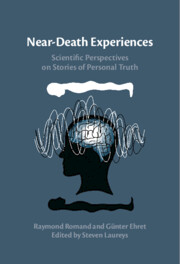Book contents
- Near-Death Experiences
- Near-Death Experiences
- Copyright page
- Epigraph
- Contents
- Preface
- Acknowledgments
- Abbreviations
- General Introduction
- Part I Consciousness
- Part II Near-Death Experiences
- Chapter 2.1 History of the Term “Near-Death Experience”
- Chapter 2.2 A Short Historical Review of Observations of NDE-Like Phenomena
- Chapter 2.3 Deathbed Phenomena
- Chapter 2.4 General Incidence of NDEs
- Chapter 2.5 Childhood and NDEs
- Chapter 2.6 Aftereffects of NDEs in Affected Persons and in NDE Researchers
- Chapter 2.7 Control of Claims of Extraordinary Experiences
- Chapter 2.8 Paranormal Explanations of NDE-Like Perceptions
- Chapter 2.9 Experimental Observations That Mimic NDE Phenomenology
- Chapter 2.10 Memories
- Chapter 2.11 NDEs in Altered States of Consciousness
- Chapter 2.12 Evaluation of Brain-Based Explanations for NDEs
- Chapter 2.13 Summary and Conclusions of Part II
- General Review and Conclusions
- Epilogue
- References
- Index
Chapter 2.12 - Evaluation of Brain-Based Explanations for NDEs
from Part II - Near-Death Experiences
Published online by Cambridge University Press: 30 August 2025
- Near-Death Experiences
- Near-Death Experiences
- Copyright page
- Epigraph
- Contents
- Preface
- Acknowledgments
- Abbreviations
- General Introduction
- Part I Consciousness
- Part II Near-Death Experiences
- Chapter 2.1 History of the Term “Near-Death Experience”
- Chapter 2.2 A Short Historical Review of Observations of NDE-Like Phenomena
- Chapter 2.3 Deathbed Phenomena
- Chapter 2.4 General Incidence of NDEs
- Chapter 2.5 Childhood and NDEs
- Chapter 2.6 Aftereffects of NDEs in Affected Persons and in NDE Researchers
- Chapter 2.7 Control of Claims of Extraordinary Experiences
- Chapter 2.8 Paranormal Explanations of NDE-Like Perceptions
- Chapter 2.9 Experimental Observations That Mimic NDE Phenomenology
- Chapter 2.10 Memories
- Chapter 2.11 NDEs in Altered States of Consciousness
- Chapter 2.12 Evaluation of Brain-Based Explanations for NDEs
- Chapter 2.13 Summary and Conclusions of Part II
- General Review and Conclusions
- Epilogue
- References
- Index
Summary
NDEs and OBEs reflect altered states of consciousness (ASCs) that can experimentally be studied via modern brain scanning and electroencephalographic methods. Scientific literature presents convincing evidence for brain-based explanations of NDEs and OBEs. The disturbance of normal multisensory integration in the temporo-parietal junction (TPJ) of the cerebral cortex via over- or under-excitation or via misalignment of sensory inputs is the most plausible and experimentally confirmed origin of OBEs. NDE generation seems to be based on information exchange in various neural networks of the brain involving different sets of brain areas for different NDE themes. When NDE themes explicitly refer to a first-person perspective, the TPJ is an excellent candidate for a major contribution to NDE occurrence. When visual phenomena are part of the NDE theme, the occipital cortex can be assumed to be strongly involved. There is a clear connection of NDEs with ASCs and the TPJ as a brain center that significantly contributes via brain-wave activity to the regulation of states of consciousness.
Keywords
Information
- Type
- Chapter
- Information
- Near-Death ExperiencesScientific Perspectives on Stories of Personal Truth, pp. 153 - 162Publisher: Cambridge University PressPrint publication year: 2025
Accessibility standard: WCAG 2.0 A
Content Navigation
Allows you to navigate directly to chapters, sections, or non‐text items through a linked table of contents, reducing the need for extensive scrolling.
Provides an interactive index, letting you go straight to where a term or subject appears in the text without manual searching.
Reading Order & Textual Equivalents
You will encounter all content (including footnotes, captions, etc.) in a clear, sequential flow, making it easier to follow with assistive tools like screen readers.
You get concise descriptions (for images, charts, or media clips), ensuring you do not miss crucial information when visual or audio elements are not accessible.
You get more than just short alt text: you have comprehensive text equivalents, transcripts, captions, or audio descriptions for substantial non‐text content, which is especially helpful for complex visuals or multimedia.
Visual Accessibility
You benefit from high‐contrast text, which improves legibility if you have low vision or if you are reading in less‐than‐ideal lighting conditions.
Structural and Technical Features
You gain clarity from ARIA (Accessible Rich Internet Applications) roles and attributes, as they help assistive technologies interpret how each part of the content functions.
